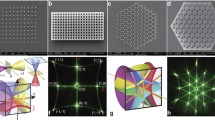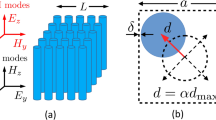Abstract
Electrodynamic Green’s functions are used to construct an analytical theory of the Bragg diffraction of polarized light in photonic crystals having a close-packed structure. For opal-based photonic crystals, the Bragg diffraction intensity is calculated with allowance for permittivity periodic modulation and for the presence of an optical crystal boundary and interlayer disordering, which usually appears during sample growth. A comprehensive study is made of the effect of the structure disorder caused by the random packing of growth layers on diffraction. For a random constructed twinned fcc structure, the average structure factor and the scattering (diffraction) cross sections (which are dependent on the linear polarization of the incident and scattered waves) are calculated. Numerical examples are used to show that the theory developed can be applied to analyze and process experimental diffraction patterns of real photonic crystals having a close-packed structure disordered in one direction.
Similar content being viewed by others
References
C. Kittel, Introduction to Solid State Physics, 5th ed. (Wiley, New York, 1976; Nauka, Moscow, 1978).
J. Ziman, Models of Disorder (Cambridge University Press, Cambridge, 1979; Mir, Moscow, 1982).
J. C. Slater, Insulators, Semiconductors, and Metals (McGraw-Hill, New York, 1967; Mir, Moscow, 1969), Chap. 6.
J. D. Joannopoulos, R. D. Meade, and J. N. Winn, Photonic Crystals: Molding of Flow of Light (Princeton University Press, Princeton, 1995).
E. Yablonovitch, Phys. Rev. Lett. 58(20), 2059 (1987); E. Yablonovitch, T. J. Gmitter, and K. M. Leung, Phys. Rev. Lett. 67 (17), 2295 (1991); E. Yablonovitch, T. J. Gmitter, R. D. Meade, A. M. Rappe, K. D. Brommer, and J. A. Joannopoulos, Phys. Rev. Lett. 67 (24), 3380 (1991).
Confined Electrons and Photons: New Physics and Applications, Ed. by E. Burstein and C. Weisbuch (Plenum, New York, 1995).
A. Blanco, E. Chomski, S. Grabtchak, M. Ibisate, S. John, S. Leonard, C. Lopez, F. Mesegure, H. Migues, J. Mondia, G. A. Ozin, O. Toader, and H. M. van Driel, Nature (London) 405, 437 (2000).
V. N. Astratov, V. N. Bogomolov, A. A. Kaplyanskii, A. V. Prokofiev, L. A. Samilovich, S. M. Samoilovich, and Y. A. Vlasov, Nuovo Cimento Soc. Ital. Fis., D 17, 1349 (1995).
K. Buch and S. John, Phys. Rev. B: Condens. Matter 58(3), 3896 (1998).
A. V. Baryshev, A. V. Ankudinov, A. A. Kaplyanskii, V. A. Kosobukin, M. F. Limonov, K. B. Samusev, and D. E. Usvyat, Fiz. Tverd. Tela (St. Petersburg) 44(9), 1573 (2002) [Phys. Solid State 44 (9), 1648 (2002)].
A. V. Baryshev, A. A. Kaplyanskii, V. A. Kosobukin, M. F. Limonov, and A. P. Skvortsov, Fiz. Tverd. Tela (St. Petersburg) 46(7), 1291 (2004) [Phys. Solid State 46 (7), 1331 (2004)].
A. V. Baryshev, A. A. Kaplyanskii, V. A. Kosobukin, M. F. Limonov, K. B. Samusev, and D. E. Usvyat, Fiz. Tverd. Tela (St. Petersburg) 45(3), 434 (2003) [Phys. Solid State 45 (3), 459 (2003)].
A. V. Baryshev, A. A. Kaplyanskii, V. A. Kosobukin, M. F. Limonov, K. B. Samusev, and D. E. Usvyat, Physica E (Amsterdam) 17, 426 (2003).
A. V. Baryshev, A. A. Kaplyanskii, V. A. Kosobukin, K. B. Samusev, D. E. Usvyat, and M. F. Limonov, Phys. Rev. B: Condens. Matter 70(11), 113 104 (2004).
H. Jeffreys and B. Swirles, Methods of Mathematical Physics (Cambridge University Press, Cambridge, 1966; Mir, Moscow, 1969), Vol. 3.
V. A. Kosobukin, Fiz. Tverd. Tela (St. Petersburg) 39(3), 560 (1997) [Phys. Solid State 39 (3), 488 (1997)].
V. N. Astratov, A. M. Adavi, S. Fricker, M. S. Skolnick, D. M. Whittacker, and P. N. Pusey, Phys. Rev. B: Condens. Matter 66(16), 165 215 (2002).
R. M. Amos, J. G. Rarity, P. R. Tapster, T. J. Shepherd, and S. C. Kitson, Phys. Rev. B: Condens. Matter 61(3), 2929 (2000).
W. Loose and B. J. Ackerson, J. Chem. Phys. 101(9), 7211 (1994).
H. M. van Driel and W. L. Vos, Phys. Rev. B: Condens. Matter 62(15), 9872 (2000).
Author information
Authors and Affiliations
Additional information
__________
Translated from Fizika Tverdogo Tela, Vol. 47, No. 11, 2005, pp. 1954–1963.
Original Russian Text Copyright © 2005 by Kosobukin.
Rights and permissions
About this article
Cite this article
Kosobukin, V.A. On the theory of diffraction of light in photonic crystals with allowance for interlayer disordering. Phys. Solid State 47, 2035–2045 (2005). https://doi.org/10.1134/1.2131141
Received:
Issue Date:
DOI: https://doi.org/10.1134/1.2131141




